Apparel exporters in Bangladesh are seeing renewed momentum from US buyers as Washington settles on a pared-down 20 per cent reciprocal tariff—a move that signals the easing of trade tensions sparked under the Trump administration.
With months of uncertainty over a potential 35 per cent tariff hike now behind them, US retailers are beginning to restart halted orders, though some remain cautious as the formal signing of the tariff deal is still pending.
“We had around $5 million worth of orders—about 300,000 pieces—put on hold,” said the Managing Director of Sparrow Group, a leading exporter with over half of its $300 million annual exports destined for the US. “But after the rate was revised down to 20 per cent, our buyers reached out and gave the green light.”
He noted that many US brands chose not to halt production or pass on additional costs during the negotiation period. “Most retailers I’ve spoken to plan to adjust retail prices slightly to account for the new tariff, even if it results in dampened demand in the coming months.”
Mixed Responses from Buyers
Asian Group, based in Chattogram with annual exports worth $340 million (93 per cent to the US), also welcomed the breakthrough. “Target and Walmart didn’t halt production,” said Khondaker Belayet Hossain, Executive Director of the group. “But others are still waiting for formal confirmation, which may take a couple more days.”
While buyers have largely absorbed the tariff impact so far, Belayet noted a subtle shift: “In April, after a 10 per cent tariff increase, some buyers informally requested up to a 3.9 per cent discount on delayed shipments—something previously unheard of.”
He expects similar discount negotiations now. “It depends on the buyer-supplier relationship. Where suppliers have leverage, buyers tend to tread more carefully.”
Belayet stressed the need for market diversification and cost optimisation. “Manufacturers must reduce costs by at least 1–2 per cent through automation and industrial engineering. We can’t afford to rely so heavily on a single market.”
Relief, But Cautious Optimism
Giant Group, which allocates 70 per cent of its capacity to the US market, also sees the tariff resolution as a reprieve.
“This reciprocal tariff brings immediate relief and helps restore our competitiveness,” said SM Majedur Rahim, Director of the company. “But buyers are still evaluating how the tariff—effective from August 7—will impact their pricing strategy.”
He warned that rising retail prices could suppress US consumer demand in the short term, though Bangladesh’s strength in low-cost, basic apparel offers a buffer.
Rakibul Alam Chowdhury, Chairman of RDM Group, which exports $65 million annually (70 per cent to the US), said some paused orders are already resuming. “Buyers who postponed shipments scheduled for after July 30 have asked us to restart production,” he noted, anticipating formal confirmations after the US reopens from the weekend.
However, uncertainty looms over the 40 per cent local value addition requirement linked to the tariff regime. “If enforced, this could pose challenges for some factories, as not all products can meet that threshold,” Chowdhury cautioned.
He also urged exporters to reduce reliance on buying houses and instead build direct ties with foreign buyers to improve in-house value addition and merchandising.
Looking Ahead
SM Khaled, Managing Director of Snowtex Group, expressed cautious relief. “A large US order had been on hold, but we’re expecting confirmation within the week. The fear of relocation has eased, but the volume and pricing are still uncertain.”
Bangladesh’s new 20 per cent tariff aligns with Vietnam’s and is more favourable than India’s 25 per cent, improving its comparative standing. Yet industry leaders say exporters must remain vigilant.
“Trump could revise India’s tariff rate or alter Vietnam’s trade privileges at any time,” warned Mohammad Hatem, President of the Bangladesh Knitwear Manufacturers and Exporters Association (BKMEA).
Hatem noted that China’s weakening export position opens opportunities for Bangladesh. “Vietnam’s dependency on Chinese raw materials and combined tariffs on Chinese goods—up to 64 per cent—could make Bangladesh more attractive to US buyers.”
“We must not allow buyers to shift the entire tariff burden onto us,” he said. “Right now, there’s no direct substitute for Bangladesh’s apparel sector—but we need to be proactive to hold that advantage.”






